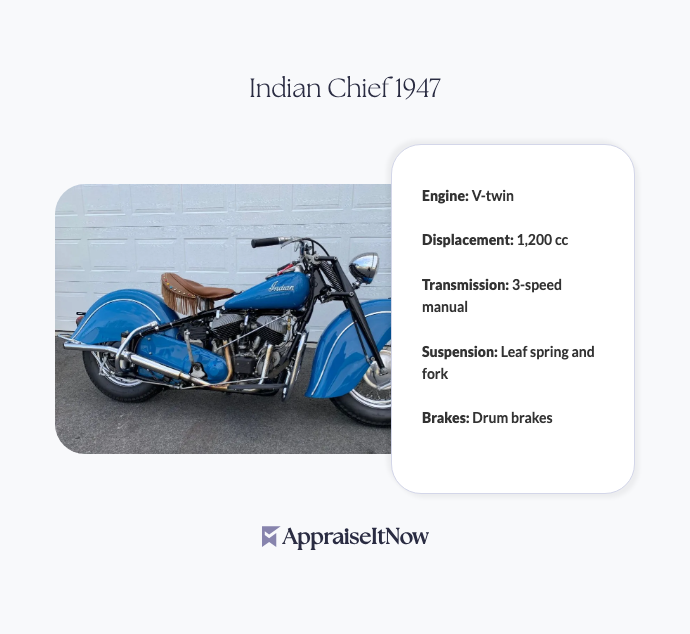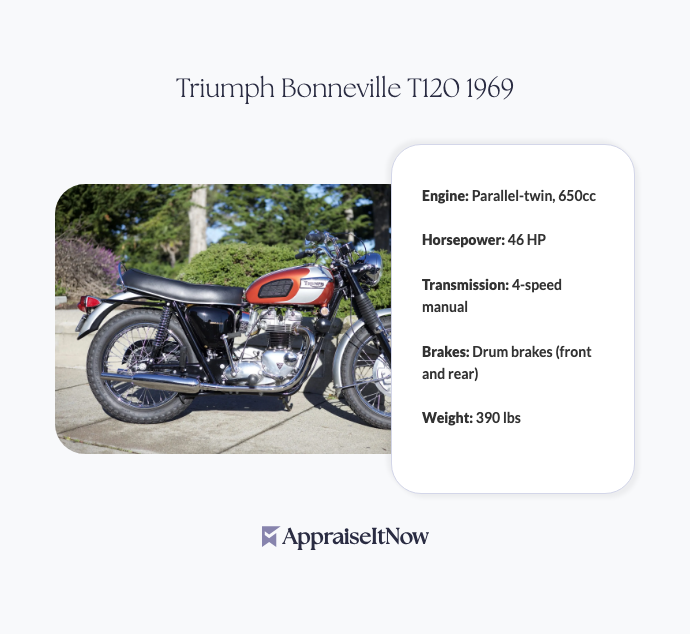<h1>How to Get Your Indian Chief 1947 Appraised</h1>
<p>The Indian Chief 1947 stands as one of America's most iconic motorcycles, blending timeless design with exceptional engineering that continues to captivate collectors and enthusiasts today. If you own one of these legendary machines, understanding its true value—typically ranging from <strong>$20,000 to $25,000</strong>—is essential whether you're considering a sale, seeking insurance coverage, or simply wanting to understand your investment's worth.</p>
<h2>Understanding the 1947 Indian Chief's Market Value</h2>
<p>Your 1947 Indian Chief represents more than just vintage transportation; it's a piece of American industrial heritage. With only <strong>500 units produced in 1947</strong>, this motorcycle qualifies as genuinely scarce in today's collector market. The iconic headlight nacelle design, powerful 1,200 cc V-twin engine, and sleek streamlined body created a motorcycle that dominated highways and captured hearts for decades.</p>
<div class="callout tip"><p><strong>Collector's Insight</strong></p>
<p>Rarity matters significantly—only 500 Indian Chiefs left the factory in 1947, making well-preserved examples increasingly difficult to locate at any price.</p></div>
<p>The Indian Chief's production run from 1922 through 1953 creates multiple variants worth different amounts. Your 1947 model falls into the later production period when refinements had been perfected but pre-war manufacturing quality standards remained. This sweet spot positions the 1947 as particularly desirable compared to earlier or later variants.</p>
<h2>What Makes Your 1947 Indian Chief Valuable</h2>
<p>Several specific factors directly influence your motorcycle's appraisal value. The V-twin engine producing consistent power, the distinctive chrome accents, and the steel construction all contribute to durability that collectors prize. Unlike modern motorcycles designed for disposability, the Indian Chief was engineered for longevity—a characteristic that translates directly into collector demand today.</p>
<p>Featured in numerous Hollywood films throughout its production years, the Indian Chief earned cultural significance beyond its mechanical excellence. This silver-screen history adds intangible but measurable value when appraisers evaluate motorcycle collectibles. When determining how much a 1947 Indian Chief is worth, professional evaluators examine both mechanical condition and historical documentation supporting its provenance.</p>
<p>The question of how many 1947 Indian Chiefs were made has a straightforward answer: <strong>500 units</strong>. This specific production number becomes important during appraisal because it establishes scarcity credentials. Fewer surviving examples mean higher values for those that do remain in good condition.</p>
<h2>Condition and Originality: The Value Drivers</h2>
<p>Your Indian Chief's condition directly determines where within the $20,000-$25,000 range your appraisal lands. Original finishes, matching serial numbers across major components, and functional authenticity all matter significantly more than cosmetic restoration.</p>
<table class='appraisal-table'>
<thead>
<tr>
<th>Condition Factor</th>
<th>Impact on Value</th>
<th>What Appraisers Examine</th>
</tr>
</thead>
<tbody>
<tr>
<td>Original paint/chrome</td>
<td>15-20% premium</td>
<td>No repainting, authentic patina</td>
</tr>
<tr>
<td>Engine numbers matching</td>
<td>10-15% premium</td>
<td>Original block, matching receipts</td>
</tr>
<tr>
<td>Mechanical function</td>
<td>20-25% premium</td>
<td>Proper ignition, fuel flow, compression</td>
</tr>
<tr>
<td>Original accessories</td>
<td>5-10% premium</td>
<td>Saddlebags, lights, mirrors intact</td>
</tr>
</tbody>
</table>
<p>Collectors often ask whether a 1946 Indian Chief is worth more than 1947 models—the answer depends primarily on condition rather than model year. Both represent excellent examples of Indian's engineering excellence, with value fluctuations driven more by individual preservation history than production dates.</p>
<h2>How Indian Motorcycles Compare to Harley-Davidson</h2>
<p>When comparing vintage motorcycles, many collectors wonder about value differences between Indian and Harley-Davidson models. The 1947 Indian Chief holds its ground remarkably well against contemporary Harleys, often commanding similar or higher prices depending on condition and history. Indian Chief motorcycles earned reputations for superior reliability and smoother operation—advantages that resonate with today's collectors seeking machines that actually run well.</p>
<p>The question of which is older, Harley or Indian, matters less than understanding that both manufacturers pioneered American motorcycle culture. Indian's heritage dating to 1901 gives your 1947 Chief historical depth that resonates in appraisals. Professional evaluators recognize Indian's commitment to quality that continues informing collector demand today.</p>
<div class="callout note"><p><strong>Market Reality</strong></p>
<p>Indian motorcycles actually hold their value exceptionally well compared to many vintage vehicles, making them attractive to collectors seeking both enjoyment and investment potential.</p></div>
<h2>Documentation and Provenance Requirements</h2>
<p>To maximize your 1947 Indian Chief's appraisal value, gather comprehensive documentation. Original purchase receipts, maintenance records, ownership history, and photographs from multiple periods all strengthen your appraisal. When appraisers evaluate classic motorcycles through professional vintage motorcycle appraisal services, documentation often determines whether an appraisal reflects market value or falls short by thousands of dollars.</p>
<p>Your motorcycle's serial number becomes crucial during professional evaluation. Original matching numbers across the frame, engine, and components significantly enhance value. Modifications, even well-intentioned restorations using incorrect parts, reduce the value that collectors will pay for authenticity.</p>
<h2>Why Professional Appraisals Matter</h2>
<p>Whether you're selling your Indian Chief, insuring it, or simply curious about its worth, a professional appraisal provides credible documentation accepted by insurers, buyers, and courts. Our certified appraisers specializing in personal property valuations bring expertise in vintage motorcycles specifically, understanding the nuanced factors that separate a $20,000 machine from a $25,000 specimen.</p>
<p>Insurance companies require detailed appraisals before issuing valuable items coverage. A professional report documenting your Indian Chief's condition, history, and current market comparables ensures you maintain adequate coverage without overpaying for protection. For those considering selling through auction houses or private sales, a certified appraisal establishes baseline expectations and strengthens negotiating position.</p>
<p>The appraisal process itself involves thorough examination of mechanical systems, electrical components, structural integrity, and aesthetic condition. Appraisers photograph documentation, test basic functions, and research comparable recent sales to establish fair market value. This comprehensive approach produces reports suitable for any purpose—personal knowledge, insurance, legal proceedings, or transaction documentation.</p>
<div class="callout tip"><p><strong>Smart Ownership</strong></p>
<p>Update your Indian Chief's appraisal every 3-5 years to reflect changing market conditions and ensure insurance coverage remains adequate.</p></div>
<h2>Market Trends Supporting Indian Chief Values</h2>
<p>Vintage motorcycle appreciation has outpaced inflation substantially over the past decade. As new motorcycle production emphasizes electronic complexity and disposability, collectors increasingly value machines designed for longevity and mechanical repair. Your 1947 Indian Chief's simplicity—no computers, no electronic fuel injection, no planned obsolescence—appeals to riders and collectors seeking authentic mechanical engagement.</p>
<p>The collectible motorcycle market continues strengthening as younger enthusiasts discover the appeal of hand-shift transmissions and mechanical honesty. This broadening collector base supports stable valuations and suggests modest appreciation potential for well-maintained examples. Unlike automobiles where vintage often means unreliability, vintage motorcycles increasingly represent machines that actually perform better than modern counterparts in specific riding contexts.</p>
<p>When considering value retention, old Indian motorcycles demonstrate impressive resilience. The question of what old Indian motorcycles are worth often surprises owners—well-preserved examples consistently appreciate or maintain value, defying the depreciation pattern of most vehicles.</p>
<h2>Getting Started with Your Appraisal</h2>
<p>When you're ready to appraise your 1947 Indian Chief, prepare detailed information about its history, condition, and any modifications. Photograph the motorcycle from multiple angles, including close-ups of any unique features, damage, or distinctive markings. Compile whatever ownership documentation exists—titles, receipts, service records, or photographs from previous decades.</p>
<p>AppraiseItNow connects you with credentialed appraisers experienced in classic and vintage motorcycles who provide USPAP-compliant valuations accepted everywhere. Our streamlined online process lets you submit photos and descriptions securely, receiving professional appraisals without requiring the motorcycle to leave your property. Whether you need appraisal documentation for insurance, sale preparation, or personal knowledge, certified professionals deliver the expertise your Indian Chief deserves.</p>
<div class="callout note"><p><strong>Key Takeaway</strong></p>
<p>Your 1947 Indian Chief's value—typically $20,000 to $25,000—reflects both its exceptional rarity with only 500 units produced and its enduring appeal as a symbol of American motorcycle engineering excellence. Professional appraisal documentation ensures you understand your asset's true worth while providing the credible valuation required for insurance, sale, or legal purposes.</p></div>







.avif)







